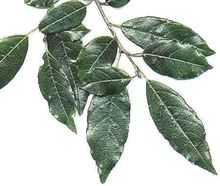Rhamnus prinoides
| Rhamnus prinoides | |
|---|---|
 | |
| Rhamnus prinoides, foliage | |
| Scientific classification | |
| Kingdom: | Plantae |
| (unranked): | Angiosperms |
| (unranked): | Eudicots |
| (unranked): | Rosids |
| Order: | Rosales |
| Family: | Rhamnaceae |
| Genus: | Rhamnus |
| Subgenus: | Rhamnus |
| Species: | R. prinoides |
| Binomial name | |
| Rhamnus prinoides L'Hér. | |
| Synonyms | |
| |
Rhamnus prinioides, the Shiny-leaf Buckthorn, is an African shrub or small tree in the family Rhamnaceae. It was first described by French botanist Charles Louis L'Héritier de Brutelle in 1789.[1]
Description
Rhamnus prinioides occurs from Ethiopia to South Africa at medium to high altitudes. They grow near streams or along forest margins. The small edible fruits are shiny red and berry-like.
Uses
The Rhamnus prinioides plant has many uses amongst the inhabitants of Africa. All parts of the plant are harvested and used for nutrition, medicine or religious purposes. In Ethiopia, where the plant is known as "gešo" or gesho,[2] it is used in a manner similar to hops: the stems are boiled and the extract mixed with honey to ferment a mead called tej.[3] It is also used in the brewing of tella, an Ethiopian beer.[4]
References
- ↑ "Rhamnus prinoides L'Hér.". Germplasm Resources Information Network (GRIN) online database. Retrieved 24 October 2010.
- ↑ Pankhurst, Rita. "Gešo ". In Encyclopaedia Aethiopica: D-Ha, edited by Siegbert Uhlig. 773. Wiesbaden, Germany: Harrassowitz Verlag, 2005
- ↑ Richard Pankhurst, Economic History of Ethiopia (Addis Ababa: Haile Selassie I University, 1968), p. 194.
- ↑ Amborn, Hermann. "Ṭälla." In Encyclopaedia Aethiopica: O-X: Vol. 4, edited by Siegbert Uhlig. 848-49. Wiesbaden: Harrassowitz, 2010.
- "Rhamnus prinoides". Plantz Afrika. Retrieved 2010-03-04.
- Trees of Southern Africa, K C Palgrave, 1984 ISBN 0-86977-081-0